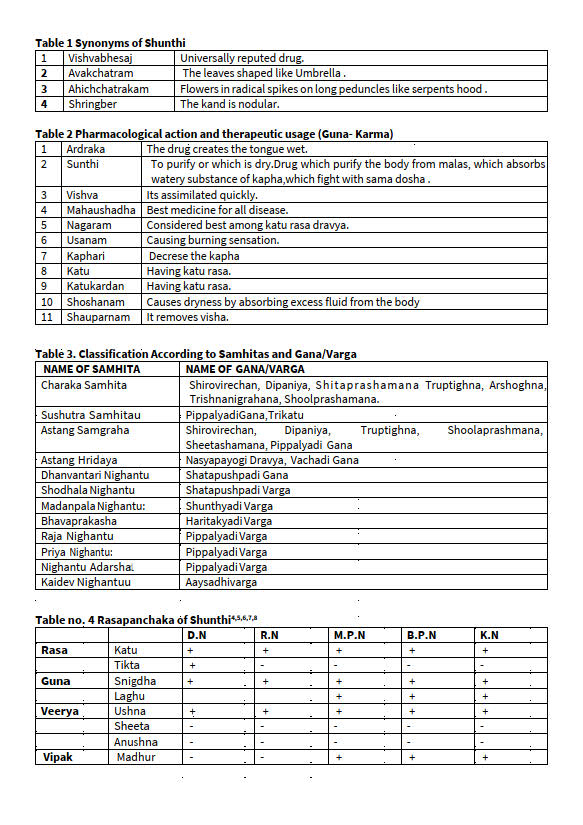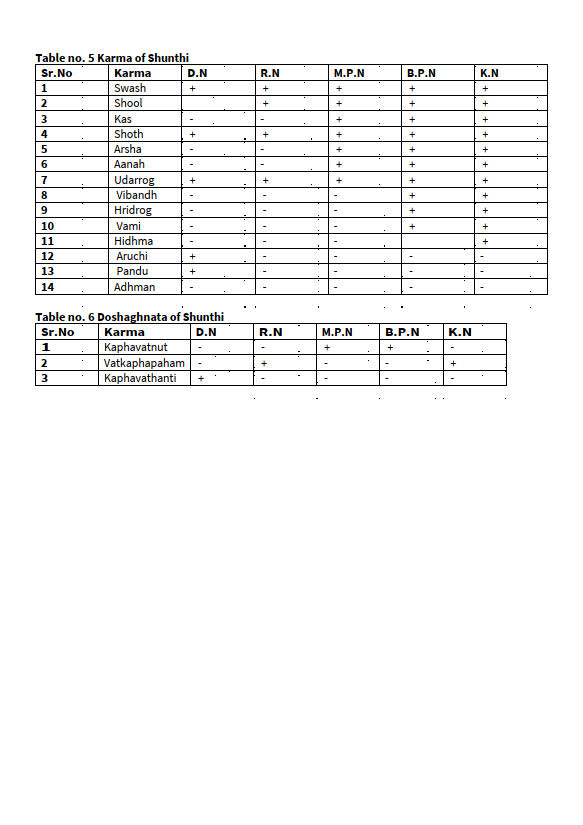Review Article
Year: 2021 |Volume: 2 | Issue: 01 |Pages: 61-69
Critical review on Pharmaco-therapeutical evaluation of Shunthi (Zingiber officinale).
About Author
Correspondence Address:
Dr. Anita Kale ( Holey) Associate professor, Dept of Dravyaguna Shri Ayurved Mahavidyalaya, Nagpur.(India) anitaholey1974@gmail .com Mobile no. 99604 89953
Date of Acceptance: 2021-01-20
Date of Publication:2021-02-10
Article-ID:IJIM_53_02_21 http://ijim.co.in
Source of Support: NIL
Conflict of Interest: NIL
How To Cite This Article: Anita Kale. Critical review on Pharmaco-therapeutical evaluation of Shunthi (Zingiber officinale) Int. J Ind. Med. 2021;2(1):61-69
Abstract
Shunthi is a dried rhizome belongs to Zingiberaceae family that is widely cultivated for its edible, underground rhizome, the term also is used to refer to this pungent, aromaticum rhizome, Shunthi is knows as a popular spice and is sometimes refer to as ginger root. It is a Non-steroidal anti-inflammatory drug (NSAIDs) are generally considered to be the most effective management for inflammation and pain. In Ayurveda it is mainly used for disease like Shoola, Amavata, Atisara, Shotha, Kasa, Shwasa, Hridroga, Hikka, Pandu, Vrana, Jvara, Kustha, Agnimandya etc. it is also included in many formulations of Vata Kapha origin diseases in Ayurveda.
Keywords: Shunthi, Zingiber officinale, Adraka, Ginger
Introduction
Ginger (Zingiber officinale Roscoe) is a sterile, reed-like plant with a pungent and aromatic rhizome on which it relies for vegetative propagation. The plant is a cultigen, that is, it is only known from cultivation.1 The word ginger comes from the ancient Sanskrit singabera ,meaning ‘ Shaped like a horn .” Shunth means to purify, fresh rhizome of ginger plant is called Adraka and Dried rhizome called as Shunthi.
Latin name – Zingiber officinale Roxb.
Family – Zingiberaceae
Shunthi is Vrishya, Balavardhaka, Brumhana, Medhya, Jeevaniya and Asthisandhanakara. Mainly used in Pandu, Rakta pitta, Yoni roga, shukra dosha, Mootra roga, Pradara roga etc. and it is pathya in vata pittaj vikara.2
Chief Characters3 It is an erect plant , that grows 3-4 feet tall Stem – annual, which rises to 3 to 4 feet in height , is solid , cylindrical ,erect , and enclosed in an imbricated membranous sheathing.
Leaves – lanceolate ,acute , smooth ,five or six inches long by about an inch in breadth ,and stand alternately on the the sheathes of the stem. The flower stalk rises by the side of the stem from six inches to a foot and like it is clothed with oval acuminate sheaths; but it is without leaves and terminates in an oval, obtuse bracteal spike.
Flowers- The flowers are of a dingy yellow colour and appear 2 or 3 at a time between the bracteal scales.
Rhizome – it has biennial or perennial ,creeping rhizome .The recent root is from 1 to 4 inches long somewhat flattened on its upper and under surface ,knotty,obtusely and irregularly brached or lobbed ,externally of a light ash colour with circular rugae ,internally yellowish white and fleshy.
Chemical Composition
1) 50% starch
2) 9%protein
3) 6-8% lipids
4) 2% protease
5) 1-3% volatile oils ,vit a and niacin.
6) 3% essential oil that cause the frangrance of the spice.
The main constituents are sesquiterpenoids with zingiberine as the main component. Lesser amount of other sesquiterpenoids (Bisabolene and farnesene) and a small monoterpenoid fraction (cineol ,citral), Pungent taste is due to non volatile phenylpropanoid derived compounds, particularly gingerols and shegoals.
External Use: Anti-inflammatory and analgesic properties, it is used as local application in swollen joints and rheumatoid arthritis. It helps to reduce cold and stiffness
Internal use:9
Digestive system: Ginger is an excellent appetizer, digestive, ant flatulent, anti-haemorrhoidal and anti-spasmodic. It helps in alleviating vatakapha and pitta. Ginger is used in anorexia, nausea, vomiting, and lossof appetite, indigestion, flatulence, abdominal pain, jaundice and piles.
Circulatory system: It purifies blood and as it stimulates heart and circulatory system. It is useful in cardiac debility, cardiac pain, elephantiasis, edema, arthritis and urticaria.
Respiratory system: It is Kaphaghna and anti-asthmatic. Tenacious sputum of pharyngitis is relieved by chewing ginger.
Reproductive system: Ginger acts as aphrodisiac and sex stimulant.
Temperature: In fever with chills, Ginger containing formulations are useful. In typhoid fever and innumerable conditions ginger juice is used as adjuvant.

img 1

img 2
Discussion
Effect on cardiovascular system: In traditional Chinese medicine, ginger is used to improve the flow of body fluids. It stimulates blood circulation throughout the body by powerful stimulatory effect on the heart muscle and by diluting blood. The improved circulation is believed to increase the cellular metabolic activity, thus contributing to the relief of cramps and tension. A Japanese study showed that active constituents in ginger reduced the blood pressure and decreased cardiac workload. Ginger reduced the formation of proinflammatory prostaglandins and thromboxane thus lowering the clotting ability of the blood .The inhibition of platelet aggregation by ginger mis more than the similar effects observed with garlic and onion .Ginger can prevent the increase in cholesterol levels following intake of cholesterol-rich diet. Ginger is also known to possess antioxidant properties.
Effect on blood pressure
Several pieces of evidence, mainly from rat studies, have suggested that ginger exerts many direct and indirect effects on blood pressure and heart rate .More recently, Ghayur and Gilani. reported that the crude extract of ginger induced a dose-dependent (0.3–3 mg/kg) fall in the arterial blood pressure of anesthetized rats. In Guinea pig paired atria, the crude extract exhibited a cardiodepressant activity on the rate and force of spontaneous contractions. In rabbit thoracic aorta preparation, the crude extract relaxed the phenylephrine induced vascular contraction at a dose 10 times higher than that required against K-induced contraction. Ca2+ channel- blocking activity was confirmed when the crude extract shifted the Ca2+ dose–response curves to the right, similar to the effect of verapamil. It also inhibited the phenylephrine control peaks in normal Ca2+-plus and Ca2+-free solutions, indicating that it acts at both the membrane-bound and the intracellular Ca2+ channels. When tested in endothelium- contraction at a dose 14 times less than that required for relaxing the PE-induced contraction.
Effect on blood clotting
The effect of an aqueous extract of ginger on platelet thromboxane-B2 (TBX2) and prostaglandin-E2 (PGE2) production was examined after giving rats a raw aqueous extract of ginger daily for a period of 4 weeks, either orally or intraperitoneally (IP). A low dose of ginger (50 mg/kg) administered either orally or IP did not produce any significant reduction in the serum TBX2 levels. However, ginger administered orally caused significant changes in the serum PGE2 at this dose. These results suggest that ginger could be used as an anti-thrombotic and anti-inflammatory agent.
Antiemetic effect
The mechanism of action of ginger's effect on nausea and vomiting remains uncertain. However, there are several proposed mechanisms. The components in ginger that are responsible for the antiemetic effect are thought to be the gingerols, shogaols, and galanolactone, a diterpenoid of ginger. Recent animal models and in vitro studies have demonstrated that ginger extract possesses antiserotoninergic and 5- HT3 receptor antagonism effects, which play an important role in the etiology of post-operative nausea and vomiting. Additionally, there was no effect of ginger on duodenal contractions or on the "motility index."
Antitussive effect : (6)-shogaol, generally more potent than (6)- gingerol, has exhibited antitussive effects.
Immunomodulatory effect: In vitro evidence indicates that ginger has immunomodulatory effects and is an effective antimicrobial and antiviral agent.
Lipid effect : Oral ingestion of ginger extract has been shown to have hypocholesterolemic, hypolipidemic, and antiatherosclerotic effects in cholesterol- fed rabbits and in rats. Inhibition of LDL oxidation and attenuated development of atherosclerosis has also been observed in apolipoprotein E-deficient mice.
Weight loss effect : Spiced foods or herbal drinks, such as those that contain ginger, have
the potential to produce significant effects on metabolic targets, such as satiety, thermogenesis, and fat oxidation. A significant clinical outcomes sometime may appear straightforwardly but also depends too strongly on full compliance of subjects. Thermogenic ingredients, such as ginger, may be considered as functional agents that could help restore a "positive energy balance" and prevent obesity.
Anti-inflammatory effect : Ginger has a long history of use as an anti- inflammatory and many of its constituents have been identified as having anti- inflammatory properties.
Ginger has been found to inhibit prostaglandin biosynthesis and interfere with the inflammatory cascade and the vanilloid nociceptor .Ginger has been shown to share pharmacological properties with non-steroidal anti-inflammatory drugs (NSAIDs) because it suppresses prostaglandin synthesis through the inhibition of cyclooxygenase-1 and cyclooxygenase-2.
Antinociceptive efffct : (6)-shogaol has produced anti-nociception and inhibited the release of substance P in rats, seemingly via the same receptor to which capsaicin binds. However, it was observed to be 100 times less potent and to elicit half the maximal effect of capsaicin.
Antioxident effect: In vitro, ginger has been shown to exhibit antioxidant effects. (6)-gingerol appears to be the antioxidant constituent present in ginger, as it was shown to protect HL-60 cells from oxidative stress. Ginger oil has dominative protective effects on DNA damage induced by H2O2. Ginger oil might act as a scavenger of oxygen radical and might be used as an antioxidant.
Radio protective effect : In vitro, pre-treatment with [6]-gingerol reduced UVB-induced intracellular reactive oxygen species levels, activation of caspase-3, -8, -9, and Fas expression. It also reduce UVB-induced expression and transactivation of COX-2. Translocation of NF-κB from cytosol to nucleus in HaCaT cells was inhibited by [6]- gingerol via suppression of IκBα phosphorylation (ser-32). Examination by EMSAs and immune histochemistry showed that topical application of [6]-gingerol (30 μM) prior to UVB irradiation (5 kJ/m2) of hairless mice, also inhibited the induction of COX-2 mRNA and protein, as well as NF-κB translocation.
Mode of action of Shunthi
Shunthi has ushana Virya and Katu Rasa properties. By virtue of these properties, The state of Mandagni might have improved. So when the Agni is improved the further production of Ama is checked at root level. Shunthi is Vata and Kapha Shamaka. Shunthi has Snigdha guna, Madhura vipaka & ushana Virya in nature. It corrected the vitiation of Vata and kapha and brought them to normal position. Hence it is mainly used in Vata kapha Dominance diseases.
Conclusion
Shunti is a dried form of Ardraka, which has many similar properties and differs in Guna, Doshagnata and Karma, Shunthi is Vishvabhehsaja in Ayurveda which helps promote Universal health. Many research works has been done to understanding its pharmacological and therapeutic action, such as Anti-oxidant action, carminative, antipyretic, anti colic, Anti-inflammatory and Anti rheumatism action and it is mainly used for the treatment of waist pain, rheumatism, cough, corhyza and bronchitis.
References
- Prof.D.Shanth kumar Lucas, Dravyaguna Vijnana, Chaukhamba Academy, Varanasi, Reprint-2013, Vol-2, P.No.-363
- Dr.K.Nishteswar, Text book of Dravyaguna, Chaukhambha Surbharati Prakashana, Varanasi, First edition-2007, P.No-307
- The ayurvedic Pharmacopoeia of India,Goverment of India,department of AYUSH,Printed by NISCAIR,New Delhi, First Edition,Part-1,volume-4,P.No- 91
- Dhanavantri, Dhanavantri Nighantu, edited by Prof. P.V.Sharma, Chaukhambha Orientalia Varanasi, 2nd edition-1998, sloka 73-74,P.No.-83.
- Madanapala nighantu of Madanapala, English translation by Dr.J.L.N. Sastry, Chaukhambha Orientalia Varanasi, 1st edition 2010 ,Sunthyadi varga , sloka 12-15 P.no- 308-309
- Bhavaprakasha nighantu of Bhavanisra commented by Dr.Bulusu Sitaram, Chaukhambha Orientalia Varanasi, reprint 2012 ,Haritakyadi varga, sloka 53- 58, P.no-137
- Raja, Raja Nighantu of Pandit Narhari edited by Dr. Indradeo Tripathi, Krisnadas Academy, Varanasi, lind edition, 1998,Pippalyadi varga, shoka 11- 20, P.No.- 135-137.
- Kaiyadeva nighantu edited and translated by Priyavat Sharma, Chaukhambha Orientalia Varanasi, reprint 2009 ,Aushadhi varga, sloka 1165-1169 , P.no- 215
- Priyavrat Sharma, Classical use of medicinal plants, Chaukhamba Visvabharati, Varanasi,First Edition-1996, Vol-I, P.No.-239.
- S. banerjee, H. I. Mullick and J. Banerjee International Journal of Pharma and Bio SciencesZingiber officinale: a natural gold jan-mar 2011; 2(1)
- Mishra, Rajesh Kumar, Anil Kumar, and Ashok Kumar. "Pharmacological activity of Zingiber officinale." International Journal of pharmaceutical and chemical sciences 1.3 (2012): 1073-1078.

